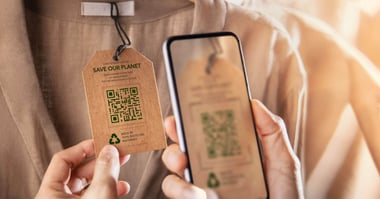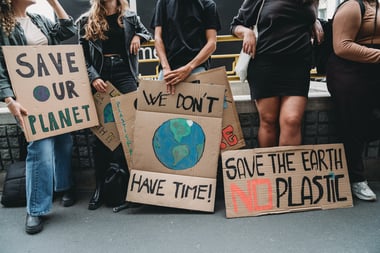
Tamara Davison
Tamara Davison is a journalist who specializes in sustainability and the environment. Reporting from around the world, she's seen firsthand the direct impact waste is having on coastal communities and our oceans. As a diver trained in ecological monitoring, the changes Tamara has seen in marine habitats inspired her to action. She's previously written for The Guardian, The Independent and the Evening Standard. She's also produced environmental documentaries for EuroNews.
As businesses start paying more attention to their environmental, sustainability, and governance (ESG) goals, plastic credits have grown in popularity.
These credits fill the financial gap in plastic recovery while also helping brands reduce their plastic footprint by paying a fee to recover waste in vulnerable areas — it’s a win-win.
Although some have criticized carbon credits, plastic credits don’t have such a stigma. That’s because they are linked to tangible waste and much easier to monitor.
It’s also a relatively new concept — so understandably, some businesses may be hesitant to sign up for plastic credit systems. As experts in plastic credits, we’re here to explain why you should pay attention to them.
Want to reduce your business’s plastic footprint? We can help. Get in touch to arrange a call to discuss which plastic credits plan will suit your business needs best.
What’s on this page?
01 | What are plastic credits?
02 | How do they work?
03 | Why are plastic credits important?
04 | The pros and cons of plastic credits
05 | Are plastic credits a solution to plastic pollution?
06 | What to look for in a plastic credit provider
07 | Watch out for greenwashing
08 | CleanHub’s plastic credits: What we offer
09 | FAQs
What are plastic credits?
Plastic credits are transferable certificates that measure the collection of a specific weight of plastic waste that has been recovered or recycled, which would have otherwise ended up littering the natural environment.
By investing in plastic credits, businesses can prevent plastic from entering the environment or clean up plastic waste that is already polluting our planet.
It allows brands and businesses to take responsibility for the plastic waste they produce and supports the removal of plastic from the environment.
These credits — usually issued by independent credit providers — represent a fixed weight of plastic that the company has recovered or recycled.
Brands usually purchase plastic credits, and the money is invested in organizations that retrieve and recycle plastic on their behalf.
Plastic credits are also different from their more famous cousin, carbon credits. As their name suggests, plastic credits target plastic waste management, while carbon credits focus on reducing global emissions. The biggest difference is that plastic waste is tangible, making it much easier to see the results of plastic credit initiatives — helping businesses stay accountable.
Out of the 430 million tons of plastic waste produced by our world each year, just 9% is recycled, while another 22% is mismanaged. Experts anticipate plastic production to grow by 40% in the next ten years.
That’s why plastic credits are essential. The system incentivizes corporate awareness at a critical time, rewards businesses that take action, supports local communities that clean up the environment — and ultimately stops some plastic from becoming waste by feeding it back into the economy.
How do they work?
For plastic credits to work, businesses that want to reduce plastic waste partner up with another organization committed to plastic cleanup projects (like CleanHub).
Together, they fund and facilitate plastic waste collection and recycling on behalf of the business. Here’s a step-by-step guide to how plastic credits work:
- Calculate the plastic footprint: The company must first conduct an audit to determine its plastic footprint (the amount of plastic waste it produces yearly). If you partner with a reputable plastic credit organization, they’ll be able to help you do this.
- Fund plastic recovery: The credit provider usually determines the price of a plastic credit. The company can choose the amount of plastic credits it purchases based on its plastic footprint.
- Get coastal communities involved: The money the business invests in plastic credits then funds plastic waste collection. This usually benefits coastal communities on the front lines of our climate crisis, who can collect and recycle the equivalent amount of waste to the business's plastic footprint.
- Have a verified impact: The best plastic credit organizations now use technology to ensure businesses can track and monitor their plastic collections via interactive dashboards and even AI.
- Tell the world: This data provides proof to share with consumers, helping brands demonstrate their environmental commitments. Brands can also share it with regulators, investors, and government bodies to ensure accountability for environmental standards.
Why are plastic credits important?
Around 85% of US plastic was sent straight to landfills in 2021, and this trend isn’t unique. However, awareness about the negative impact of plastic waste is growing. At least 64% of consumers expect brands to help them support plastic-removal schemes.
Plastic credits are one way to do this — and here are the top reasons why it’s they’re so important.
Reduces plastic pollution
Scientists believe there are over 21,000 pieces of plastic floating in our oceans for every person on the planet.
Plastic credits reduce plastic pollution by funding and incentivizing wide-scale plastic collections. For example, CleanHub has helped businesses collect over 8 million kg of waste worldwide that would otherwise continue polluting our seas and coastlines.
Funds plastic recovery
A study in 2023 revealed that 40% of the world’s population lives in areas where waste generation exceeds management capacities. Developing countries bear the brunt of this because they usually lack the proper infrastructure and sometimes handle imported waste from other countries, such as Europe and the US.
When businesses buy plastic credits, the money bridges this financial gap, helping to establish effective collection systems with technology and advanced processes that streamline the process.
The funding also means plastic collectors get paid a fair wage, helping them clean up local areas that bear the brunt of our world’s plastic problem.
Contributes to a circular economy
A circular economy aims to keep materials circulating for as long as possible instead of letting them go to waste.
Plastic credits not only fund plastic waste collections, but also waste management — with material either being recycled or converted into fuel. This way, we can reduce excess waste in our environment, whilst also utilizing the materials and enhancing circular economy goals.
Plastic credits are also part of the extended producer responsibility (EPR) framework in some countries, a policy that assigns manufacturers responsibility for end-of-life management. EPR further incentivizes the idea of a circular economy, encouraging businesses to find cost-effective ways to manage unnecessary waste.

The pros and cons of plastic credits
Like most other sustainable practices, there are pros and cons to plastic credits that you should know about.
Pros
Removes plastic waste from the environment: Each credit a business invests in represents a specific weight of waste. Thousands of brands are helping to clean up plastic waste one ton at a time. Take Sunday Riley, for instance, which has helped recover 32,740 kg of plastic waste since August 2023 (and counting!) with the help of CleanHub.
Supports coastal communities: Mismanaged waste kills up to 1 million people a year and disproportionately impacts waste management workers. Plastic credit programs help improve the lives of informal waste pickers by instilling safety protocols, training, and regulations to ensure their workplaces are safe.
Helps businesses stand out: Businesses can show their commitment to the environment by investing in effective waste management through plastic credits. Since 91% of consumers are concerned about plastic waste, using plastic credits can help you gain the support of more conscious customers.
Cons
Could lead to greenwashing: Plastic credits may be misused when businesses make false or misleading sustainability statements about their plastic efforts. That’s why partnering with organizations that ensure traceability and tracking is essential so you and your customers know exactly what plastic is recovered.
Lack of global standards on plastic credits: There are no global standards for plastic credits yet. This means little oversight of how credit systems work or whether their claims are valid, further adding to greenwashing concerns. A lack of cohesion on plastic credits' cost also complicates this.
It’s not a silver bullet to our planet’s waste: It’s impossible to know exactly how much plastic is in our ocean, but we’ll never be able to clean up all waste using plastic credits alone. Instead, they need to be part of a more comprehensive sustainability plan that addresses waste in other ways (such as developing alternative packaging materials).
|
Pros |
Cons |
|
Recovers millions of tons of plastic waste that pollutes our environment and harms our wildlife |
Can be misleading if not monitored correctly |
|
Supports coastal communities and helps keep informal waste pickers safe in their workplace |
No global standards (so far), meaning systems can differ between each organization |
|
Helps businesses attract conscious customers who care about the environment |
This isn’t the answer to our world’s waste problem — but it is a step in the right direction |
Are plastic credits a solution to plastic pollution?
When done right, plastic credits are part of a solution to plastic pollution. They help incentivize more action and encourage awareness among business leaders and their customers.
While it’s a partial solution, it is by no means an answer to our world's plastic crisis. We can’t let companies view this as an excuse to continue producing plastic in the first place.
Plastic credits are a small step toward ridding our environment of waste, but the bottom line is that we need to work on stopping the manufacturing of virgin plastic in the first place.
What to look for in a plastic credit provider
Many plastic credit providers promise to help companies make a real difference, so it may feel daunting to select the right one.
So, here’s a checklist of what you should look for from a plastic credit provider:
Transparency: Your plastic credit provider should provide comprehensive information about which plastic retrieval groups they work with, where your investment goes, and their efforts to support the environment.
Traceability: Plastic credit providers should be able to identify how much plastic waste is collected on your behalf and where it's recycled or reused. Traceability technology is the easiest way to facilitate this, so look for organizations offering real-time data on your impact down to the last gram.
Social Impact: Do you know who your investments are helping? Plastic credits aren’t just about collecting waste; they also ensure that the people working in this industry have a safe workspace, equal working rights, and health benefits. Choose a provider that has direct partnerships with these local groups.
Verification: Some plastic credit providers have received backing from independent sustainability initiatives. For example, CleanHub was the first plastic credit system to be verified by industry leaders in auditing environmental impact, TÜV SÜD. This kind of accreditation gives the plastic credit market more credibility and means it has the support of leading organizations committed to the environment.
Additionality: The plastic credit providers should be able to demonstrate that the plastic they collected wouldn’t have been recycled anyway before their involvement. This is called additionality, which must be verified through auditing and tracking processes. It helps guarantee the programs are having a real impact.
Watch out for greenwashing
It’s time to address the elephant in the room. In 2021, the World Economic Forum wrote about the ‘Wild West of plastic credits and offsets,’ suggesting businesses could abuse this largely unregulated market.
The U.N. Environment Programme also claimed plastic credits may lead to greenwashing if they’re not used right, pointing out: “Plastic credits are not a long-term solution but rather a short-term remedy while we move to better waste and resource management systems.”
Some plastic credits may enable greenwashing by allowing businesses to continue producing plastic instead of working to find replacements for their output. But it doesn’t have to be this way. That’s why CleanHub also offers the chance for brands to have a packaging assessment from one of our experts, who can help them figure out how to reduce single-use plastics on their production line.
Credits should be part of the broader sustainability puzzle, not the only solution brands must focus on. To avoid greenwashing, we also need to implement plastic credits properly. This requires more incentives for EPR policies and enhanced support mechanisms that help business leaders get involved with reputable plastic credit initiatives.
The current plastic credit market can serve as a vital blueprint for scaling sustainable efforts in the future, while unlocking waste management for thousands of coastal families. By giving waste value, plastic credit systems can help transform how the world views waste.

CleanHub’s plastic credits: What we offer
CleanHub is one of the leading plastic credit organizations in Europe. We work with hundreds of businesses and coastal communities around the world to clean up our oceans and stop plastic waste. But what makes us different?
1. First plastic credit organization to receive TÜV SÜD verification
In 2023, CleanHub became the first plastic credit system in the world to be verified by TÜV SÜD, an industry leader in environmental audits. We’ve also received financial backing from the European Union’s European Fund for Regional Development (EFRE). With such big industry players on our side, you can trust us to take our job seriously.
2. We don’t just focus on recyclables
We won’t sugarcoat it: 80% of ocean waste is non-recyclable plastic. Rather than skirt around this issue, we tackle it head-on. That’s why we have teamed up with co-processing facilities to turn non-recyclable plastic into fuel for the cement industry — an innovative way to give this waste another purpose.
3. Trash-tracking technology provides full transparency
CleanHub has also developed industry-leading technology that tracks and monitors our processes from start to finish. Clients can monitor their progress with our ISO-verified plastic credits platform, which helps you see plastic collections in real time.
4. CleanHub has a bigger waste management goal
We’ve helped businesses collect over 8 million kg of plastic waste from the ocean, and we’re just getting started. We aim to build a robust waste management infrastructure that can transform waste management worldwide.
5. Work closely with communities around the world
We work with vulnerable coastal communities in India, Indonesia, Cambodia, and Tanzania. But we don’t just sit in our office in Germany and watch our projects from afar. Our team is spread across the globe, from London to the Philippines to India, getting involved with local projects and ensuring we’re making a positive difference. Some of our additional projects include beach clean-ups and educational programs for children in areas vulnerable to plastic pollution
6. You can showcase your efforts to your customers
Our tracking technology can be placed on your website and give your customers a real-time glimpse into plastic collections happening on your behalf. Our work also speaks for itself: check out our brand directory to see how this technology works for hundreds of our partner brands.
7. We really care about our planet
CleanHub was founded by surfers, nature lovers, and travelers who were horrified by the plastic waste problem accumulating worldwide. We’ve got a long way to go, but we haven’t lost sight of who we are and why this project is essential — and that’s something we channel into all our partnerships.
Summary
The plastic credit market is still in its formative years, but it has a lot of potential. By tackling greenwashing concerns and prioritizing transparency, we feel hopeful about its future.
If done right, plastic credits can help reduce plastic waste, inspire a new generation of sustainably minded companies, and transform the lives of coastal communities without access to waste management.
Waste is a construct, and that needs to change in our lifetime. A circular economy future where waste is repurposed is entirely possible — plastic credits are part of that.
Want to reduce your business’s plastic footprint? We can help. Get in touch to arrange a call to discuss which plastic credits plan will suit your business needs best.
FAQs
How much is a plastic credit?
Plastic credits vary in price depending on the organization you choose to work with (which is why regulation is necessary). At CleanHub, we offer various pricing packages. You can pay a percentage of products sold, pay for an entire collection equivalent to your plastic footprint — or go even further and collect more to help you go beyond plastic neutrality.
What are plastic credits?
Plastic credits represent a fixed weight of plastic that a business has helped remove from the environment. It’s a way for companies to take responsibility for their plastic output while supporting communities worldwide.
How do you sell plastic credits?
The buying and selling processes for plastic credits depend on the facilitator you work with. This is why selecting the right credit provider for your brand’s needs is crucial. Make sure you shop around to find a partner that works for you.

.webp)

.webp?width=380&name=ESG-laptop%20(1).webp)
.webp?width=380&name=CleanHub-processing%20(1).webp)

.webp?width=380&name=Diversity-and-inclusion%20(1).webp)



.webp?width=380&name=DEI%20(1).webp)

